Typology, Preservation, and Regeneration of the Post-1949 Industrial Heritage in China: A Case Study of Shanghai
Abstract
:1. Introduction
2. Literature Review
2.1. International Industrial Heritage
2.2. China’s Industrial Heritage
3. Research Methods
3.1. Case Selection
3.2. Data Collection
3.3. Data Analysis
4. Results
4.1. Geographical Distribution
4.2. Industrial Type
4.3. Spatial Form
4.4. Temporal Evolution
4.5. Preservation and Regeneration
5. Conclusions
Author Contributions
Funding
Institutional Review Board Statement
Informed Consent Statement
Data Availability Statement
Conflicts of Interest
References
- Harris, F. From the industrial revolution to the heritage industry. Geogr. Mag. 1989, 61, 38–42. [Google Scholar]
- Jixiang, S. Focus on New Cultural Heritage: Protection of Industrial Heritage. Beijing Plan. Rev. 2007, 2, 11–17. [Google Scholar]
- de Haan, D. Industrial Heritage Re-Tooled: The TICCIH Guide to Industrial Heritage Conservation. Ind. Archaeol. Rev. 2013, 35, 82–83. [Google Scholar] [CrossRef]
- United Nations Educational, Scientific and Cultural Organization—UNESCO. Convention Concerning the Preservation of the World Cultural and Natural Heritage. 1972. Available online: https://whc.unesco.org/en/conventiontext/ (accessed on 20 June 2022).
- ICOMOS. The Dublin Principles. 17th ICOMOS General Assembly. 2011. Available online: https://www.icomos.org/Paris2011/GA2011_ICOMOS_TICCIH_joint_principles_EN_FR_final_20120110.pdf (accessed on 20 June 2022).
- Mullen, A. China Manufacturing: Everything You Need to Know. South China Morning Post, 16 December 2020. Available online: https://www.scmp.com/economy/china-economy/article/3114176/china-manufacturing-everything-you-need-know(accessed on 15 July 2022).
- National Bureau of Statistics of China. China Statistical Yearbook. 2021. Available online: http://www.stats.gov.cn/tjsj/ndsj/2021/indexch.htm (accessed on 1 January 2022).
- Subin, X.; Nobuo, A. Comprehensive Research on the Preservation System of Modern Industrial Heritage Sites in China; China City Press: Beijing, China, 2021. [Google Scholar]
- Jie, C.; Judd, B.; Hawken, S. Adaptive Reuse of Industrial Heritage for Cultural Purposes in Three Chinese Megacities. In Proceedings of the COBRA AUBEA 2015, Sydney, Australia, 8 July 2015. [Google Scholar]
- O’Connor, J.; Gu, X. Creative industry clusters in Shanghai: A success story? Int. J. Cult. Policy 2014, 20, 1–20. [Google Scholar] [CrossRef]
- Song, Z. Conservation and Adaptive Reuse of Shanghai lndustrial Heritage. Archit. J. 2006, 5, 16–20. [Google Scholar] [CrossRef]
- Pendlebury, J.; Wang, Y.W.; Law, A. Re-using ‘uncomfortable heritage’: The case of the 1933 building, Shanghai. Int. J. Herit. Stud. 2018, 24, 211–229. [Google Scholar] [CrossRef]
- Sun, M.; Chen, C. Renovation of industrial heritage sites and sustainable urban regeneration in post-industrial Shanghai. J. Urban Aff. 2021. [Google Scholar] [CrossRef]
- Rix, M. Industrial Archaeology; Historical Association: London, UK, 1967. [Google Scholar]
- Hudson, K. World Industrial Archaeology; CUP Archive: London, UK, 1979. [Google Scholar]
- Krige, S. ‘The power of power’: Power stations as industrial heritage and their place in history and heritage education. Yesterday Today 2010, 5, 107–126. [Google Scholar]
- The International Committee for the Conservation of Industrial Heritage—TICCIH. The Nizhny Tagil Charter for the Industrial Heritage. 2003. Available online: https://www.icomos.org/18thapril/2006/nizhny-tagil-charter-e.pdf (accessed on 20 June 2022).
- Dean, C.; Donnellan, C.; Pratt, A.C. Tate Modern: Pushing the limits of regeneration. City Cult. Soc. 2010, 1, 79–87. [Google Scholar] [CrossRef]
- Bellakova, E. Analysis of Industrial Architectural Heritage-Iron and Steel Plants as a Development Potential. Procedia Eng. 2016, 161, 1926–1931. [Google Scholar] [CrossRef]
- Jonsen-Verbeke, M. Industrial heritage: A nexus for sustainable tourism development. Tour. Geogr. 1999, 1, 70–85. [Google Scholar] [CrossRef]
- Abad, C. Valuation of Industrial Heritage in Terms of Sustainability: Some Cases of Tourist Reference in Spain. Sustainability 2020, 12, 9216. [Google Scholar] [CrossRef]
- Edwards, J.A.; Llurdés, I. Mines and quarries. Ann. Tour. Res. 1996, 23, 341–363. [Google Scholar] [CrossRef]
- Merwe, C.; Rogerson, C.M. Industrial heritage tourism at the ‘Big Hole’, Kimberley, South Africa. Afr. J. Phys. Health Educ. Recreat. Dance 2013, 19, 155–171. [Google Scholar]
- Perfetto, M.C.; Vargas-Sanchez, A. Towards a Smart Tourism Business Ecosystem based on Industrial Heritage: Research perspectives from the mining region of Rio Tinto, Spain. J. Herit. Tour. 2018, 13, 528–549. [Google Scholar] [CrossRef]
- Filler, M. Designing the High Line: Gansevoort Street to 30th Street. N. Y. Rev. Books 2009, 56, 12. [Google Scholar]
- Copic, S.; Dordević, J.; Lukic, T.; Stojanovic, V.; Tumaric, A. Transformation of industrial heritage: An example of tourism industry development in the Ruhr area (Germany). Geogr. Pannonica 2014, 18, 43–50. [Google Scholar] [CrossRef]
- Berger, S.; Wicke, C.; Berger, S.; Wicke, C. A post-industrial mindscape? The popularization of industrial heritage in the Ruhr and the representation of its regional identity. ABA J. 1995, 81, 30–31. [Google Scholar] [CrossRef]
- Siebel, W. Industrial Past and Urban Future in the Ruhr; Anglo-German Foundation for The Study of Industrial Society Book Series; Palgrave Macmillan: London, UK, 1999; pp. 123–134. [Google Scholar] [CrossRef]
- Szromek, A.R.; Herman, K.; Naramski, M. Sustainable development of industrial heritage tourism—A case study of the Industrial Monuments Route in Poland. Tour. Manag. 2021, 83, 104252. [Google Scholar] [CrossRef]
- Hidalgo-Giralt, C.; Palacios-García, A.; Barrado-Timón, D.; Rodríguez-Esteban, J. Urban Industrial Tourism: Cultural Sustainability as a Tool for Confronting Overtourism—Cases of Madrid, Brussels, and Copenhagen. Sustainability 2021, 13, 4694. [Google Scholar] [CrossRef]
- Simpson, C.R. Soho, The Artist in the City; University of Chicago Press: Chicago, IL, USA, 1981. [Google Scholar] [CrossRef]
- Mengusoglu, N.; Boyacioglu, E. Reuse of Industrial Built Heritage for Residential Purposes in Manchester. Metu J. Fac. Archit. 2013, 30, 117–138. [Google Scholar] [CrossRef]
- Ifko, S. Comprehensive Management of Industrial Heritage Sites as A Basis for Sustainable Regeneration. Procedia Eng. 2016, 161, 2040–2045. [Google Scholar] [CrossRef]
- Landorf, C. A Framework for Sustainable Heritage Management: A Study of UK Industrial Heritage Sites. Int. J. Herit. Stud. 2009, 15, 494–510. [Google Scholar] [CrossRef]
- Virginija, J.; Martynas, R. Models of cultural heritage management. Transform. Bus. Econ. 2014, 13, 236–256. [Google Scholar]
- Murphy, M.; Mcgovern, E.; Pavia, S. Historic building information modelling (HBIM). Struct. Surv. 2015, 27, 311–327. [Google Scholar] [CrossRef]
- Oreni, D. From 3D Content Models to HBIM for Conservation and Management of Built Heritage. Comput. Soc. 2013, 7974, 344–357. [Google Scholar] [CrossRef]
- Agapiou, A.; Lysandrou, V.; Themistocleous, K.; Hadjimitsis, D.G. Risk assessment of cultural heritage sites clusters using satellite imagery and GIS: The case study of Paphos District, Cyprus. Nat. Hazards 2016, 83, S5–S20. [Google Scholar] [CrossRef]
- Taksa, L. Machines and Ghosts: Politics, Industrial Heritage and the History of Working Life at the Eveleigh Workshops. Labour Hist. 2003, 85, 65–88. [Google Scholar] [CrossRef]
- Shaoming, L. Ruins, or Landscape? A study on the development and design of the urban port industrial district. Huazhong Archit. 1999, 2, 102–105. [Google Scholar]
- Hong, Y. A Thinking on the Development of Industry Tourism in China. Resour. Dev. Mark. 1999, 15, 2. [Google Scholar] [CrossRef]
- Hui, Z.; Feng, Q. Analysis of the preservation value of Shanghai’s 1840–1949 industrial heritage architecture. Archit. J. 2000, 11, 43–47. [Google Scholar] [CrossRef]
- Wuxi Proposal–Focusing on Industrial Heritage Conservation in a Period of High Economic Development; Archicreation: Wuxi, China, 2006; pp. 199–200.
- Jianguo, W.; Nan, J. Protective Reuse of Chinese lndustrial Historic Building Heritage in the Post-industrial Age. Archit. J. 2006, X3, 8–11. [Google Scholar] [CrossRef]
- Boying, L. A Review of Research on China’s Industrial Architectural Heritage. New Archit. 2012, TU27, 6. [Google Scholar] [CrossRef]
- Fuying, L.; Yang, X.; Shunjiang, H. A Study on the Modern Textile Industry Building Heritages in Shanghai. World Archit. 2020, 6, 4–9. [Google Scholar]
- Song, Z. Industrial Heritage Conservation and Regeneration in Redevelopment Areas on Both Sides of the Huangpu River in Shanghai. Urban Plan. Forum 2015, 2, 102–109. [Google Scholar] [CrossRef]
- Yuquan, T. Distribution and Integrity Protection of the Chinese Eastern Railroad Heritage. Urban Dev. Stud. 2013, 6, 41–46. [Google Scholar] [CrossRef]
- Boying, L.; Kuang, L. Conservation Planning and Remodeling Design for ClSW Industrial Heritage. Archit. J. 2012, 6, 30–35. [Google Scholar] [CrossRef]
- Jie, Z.; Jianxin, H.; Yan, L.; Bingbing, Z. Regeneration of Jingdezhen ceramic cultural heritage based on overall planning. Archit. Pract. 2021, 6, 70–73. [Google Scholar]
- Boying, L.; Kuang, L. Study on the System of Beijing Industrial Heritage Conservation and Reuse. Archit. J. 2010, 6, 1–6. [Google Scholar] [CrossRef]
- Hong, J.; Subin, X.; Nobuo, A. Overview of Modern Industrial Development in Tianjin and Classification of Industrial Remains. Beijing Plan. Rev. 2011, 1, 26–31. [Google Scholar]
- Yan, Z.; Yanwei, C. Interpreting the Cultural Connotation of Beijing’s Modern lndustrial Heritages: From the Perspectives of Danwei in Urban China. Urban Dev. Stud. 2013, 20, 23–28. [Google Scholar] [CrossRef]
- Chaoyu, M.; Lin, W.; Minghua, X. Preservation-regeneration and Urban Design Practice of the Shanghai Baosteel Stainless Steel Zone. Time Archit. 2018, 6, 162–167. [Google Scholar]
- Lei, W.; Shaojun, Z. An Introduction to the Conservation and Reuse of Industrial Heritage: The Case of China Industrial Museum. Chin. Mus. 2013, 3, 89–93. [Google Scholar]
- Jiancang, L. A Study of Conservation Models for Industrial Heritage of Modern Times. Southeast Cult. 2011, 4, 14–19. [Google Scholar]
- Kai, W.; Chengcai, T.; Jiaming, L. A Measuring Model on Tourist Satisfaction Index in Cultural Creative-type Tourism Destination—A Case of 798 Art Zone in Beijing. Tour. Trib. 2011, 26, 36–44. [Google Scholar] [CrossRef]
- Minghua, X.; Lin, W. Preservation and Regeneration of the Industrial Landscape of the City Centre in Shanghai: A Case Study of the M50 Industrial Transformation and Artistic, Creative Development. Time Archit. 2019, 3, 163–169. [Google Scholar]
- Kongjian, Y.; Wei, P. Understanding design: Reuse of old industrial sites in Zhongshan Qijiang Park. Archit. J. 2002, 8, 47–52. [Google Scholar] [CrossRef]
- Min, Y.; Xu, X.; Yiming, Z.; Yu, L.; Shengyu, Z. Design Strategy of Old Industrial Bases Follow City Transition. Planners 2015, 31, 130–135. [Google Scholar]
- Xin, Q. New Standards for National Industrial Heritage. People’s Daily, 11 July 2022. [Google Scholar]
- Song, Z.; Peng, C. Conservation of Shanghai Industrial Building Heritage and Development of Creative Industry—Park: Based on Investigation, Analysis and Consideration on Hongkou District. Archit. J. 2010, 12, 12–16. [Google Scholar] [CrossRef]
- Bo, W.; Wenlong, R. Research on the preservation and regeneration of industrial heritage in Jiangsu Province. Jiangsu Soc. Sci. 2021, 9, 232–240. [Google Scholar]
- Jixiang, S. New Developments in China’s Cultural Heritage Conservation in a Global Perspective. Contemprary China World 2022, 1, 53–68. [Google Scholar]
- He, J.; Liu, J.; Xu, S. Spatial-temporal evolution of modern urban industry in China from 1840 to 1949. City Plan. Rev. 2021, 9, 79–88. [Google Scholar]
- Zheng, J.; Wei, M. Study on the application of BIM+ technology in the preservation of industrial heritage of Middle East Railway—Jilin Province Gongzhuling City as an example. Sichuan Build. Mater. 2022, 48, 3. [Google Scholar]
- Lin, W.; Minghua, X.; Chaoyu, M. Development Trend and System Construction of lndustrial Heritage Preservation. Shanghai Urban Plan. Rev. 2017, 6, 15–22. [Google Scholar]
- Chang, C.; Hong, C.; Sidong, L. Research on the Difficulties and Countermeasures of Shanghai lndustrial Heritage Protection. Sci. Dev. 2018, 4, 97–107. [Google Scholar] [CrossRef]
- Martínez, P. Urban authenticity at stake: A new framework for its definition from the perspective of heritage at the Shanghai Music Valley. Cities 2017, 70, 55–64. [Google Scholar] [CrossRef]
- Yazar, M.; Hestad, D.; Mangalagiu, D.; Ma, Y.; Thornton, T.F.; Saysel, A.K.; Zhu, D. Enabling environments for regime destabilization towards sustainable urban transitions in megacities: Comparing Shanghai and Istanbul. Clim. Change 2020, 160, 727–752. [Google Scholar] [CrossRef]
- Wang, J. ‘Art in capital’: Shaping distinctiveness in a culture-led urban regeneration project in Red Town, Shanghai. Cities 2009, 26, 318–330. [Google Scholar] [CrossRef]
- Peng, Z.; Xiaojing, W. Evolution of Transformation Policy and Conservation & Regeneration of Industrial Architectural Heritages: A Case Study on Shanghai. City Plan. Rev. 2016, 9, 75–83. [Google Scholar] [CrossRef]
- Shanghai. Measures of Shanghai Municipality for the Preservation and Management of China’s 1840–1949 Heritage Architecture. 5 December 1991.
- Shanghai. Regulations of Shanghai Municipality on the Preservation of Historical and Cultural Zones and Heritage Architecture. 25 July 2002.
- Ying, S. Study on the Conservation and Reuse of Industrial Heritage in Shanghai; Fudan University Press: Shanghai, China, 2014. [Google Scholar]
- Chenghao, L.; Yijun, T. Tracing the Century-Old Industrial Buildings in Shanghai; Tongji University Press: Shanghai, China, 2017. [Google Scholar]
- Shanghai Federation of Economic Organizations; Shanghai Federation of Industrial Economics. Shanghai Industrial Story from 1921–2021; Xuelin Press: Shanghai, China, 2021.
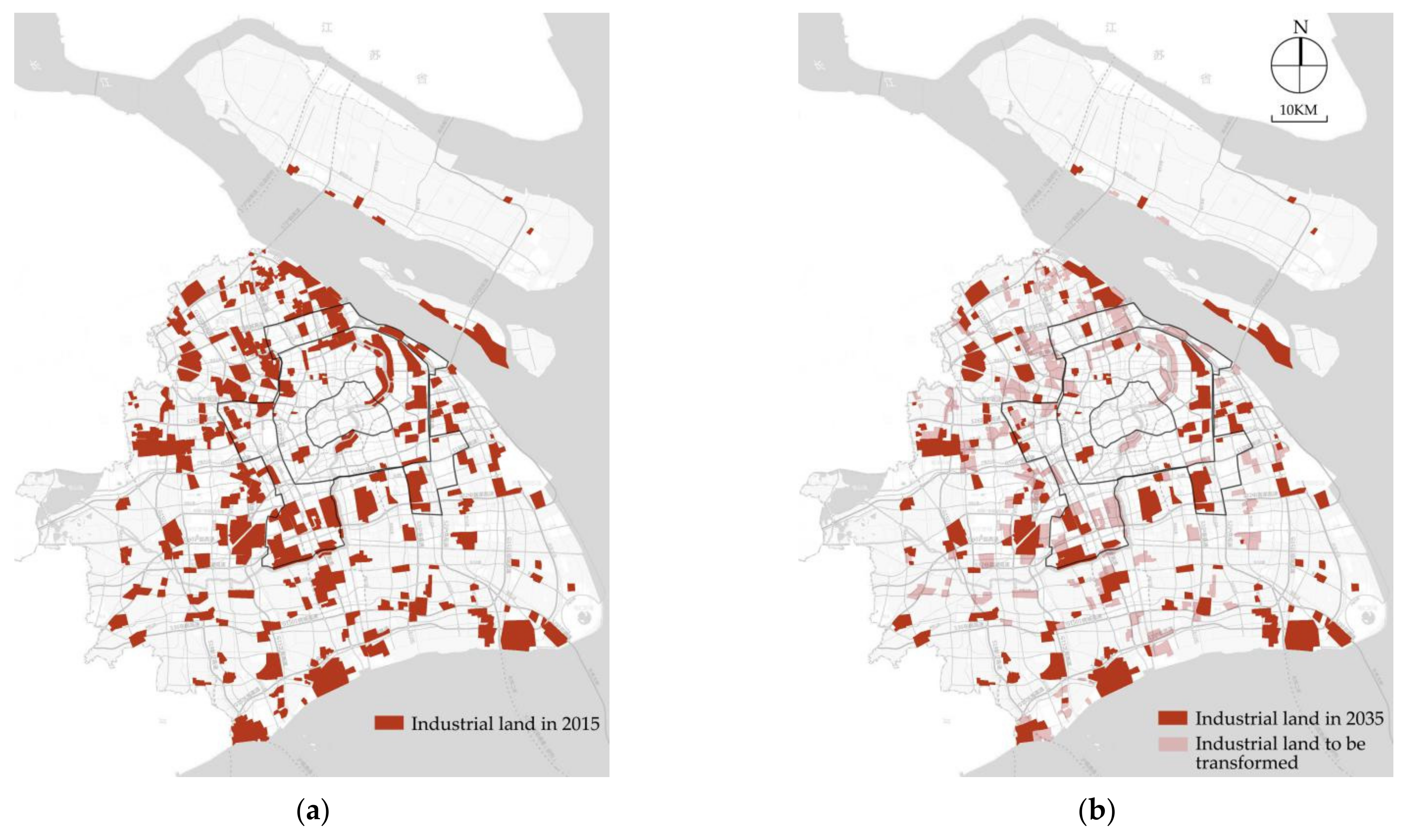
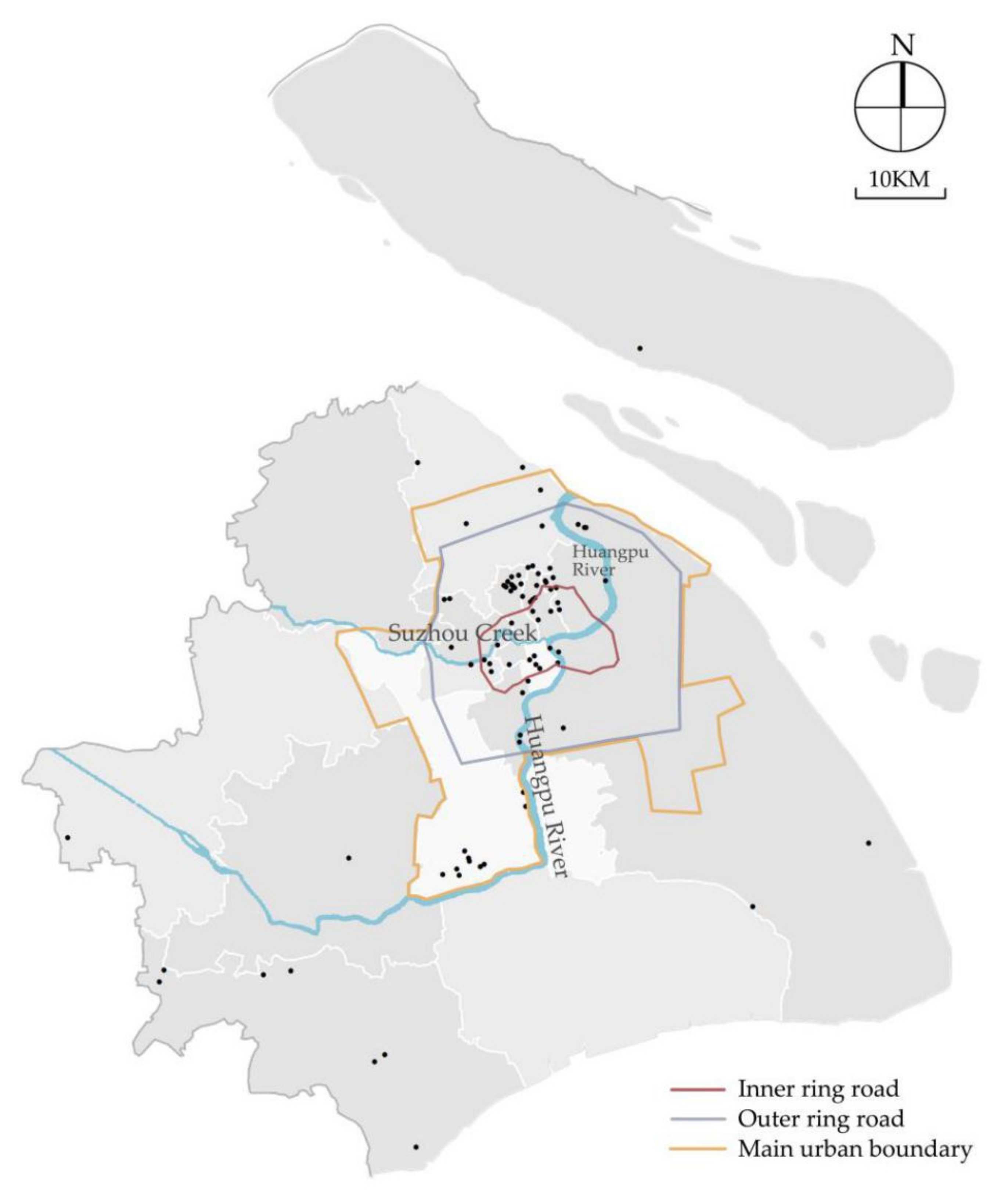


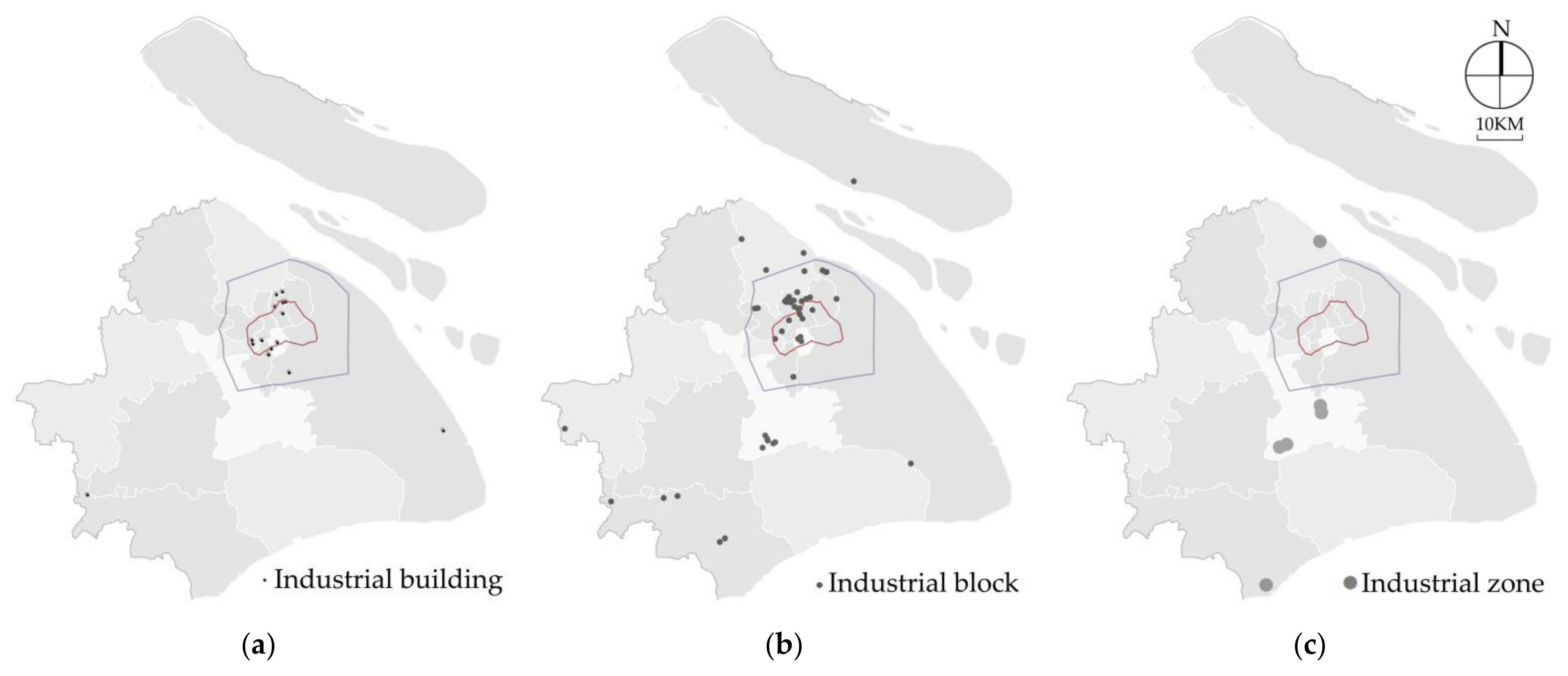
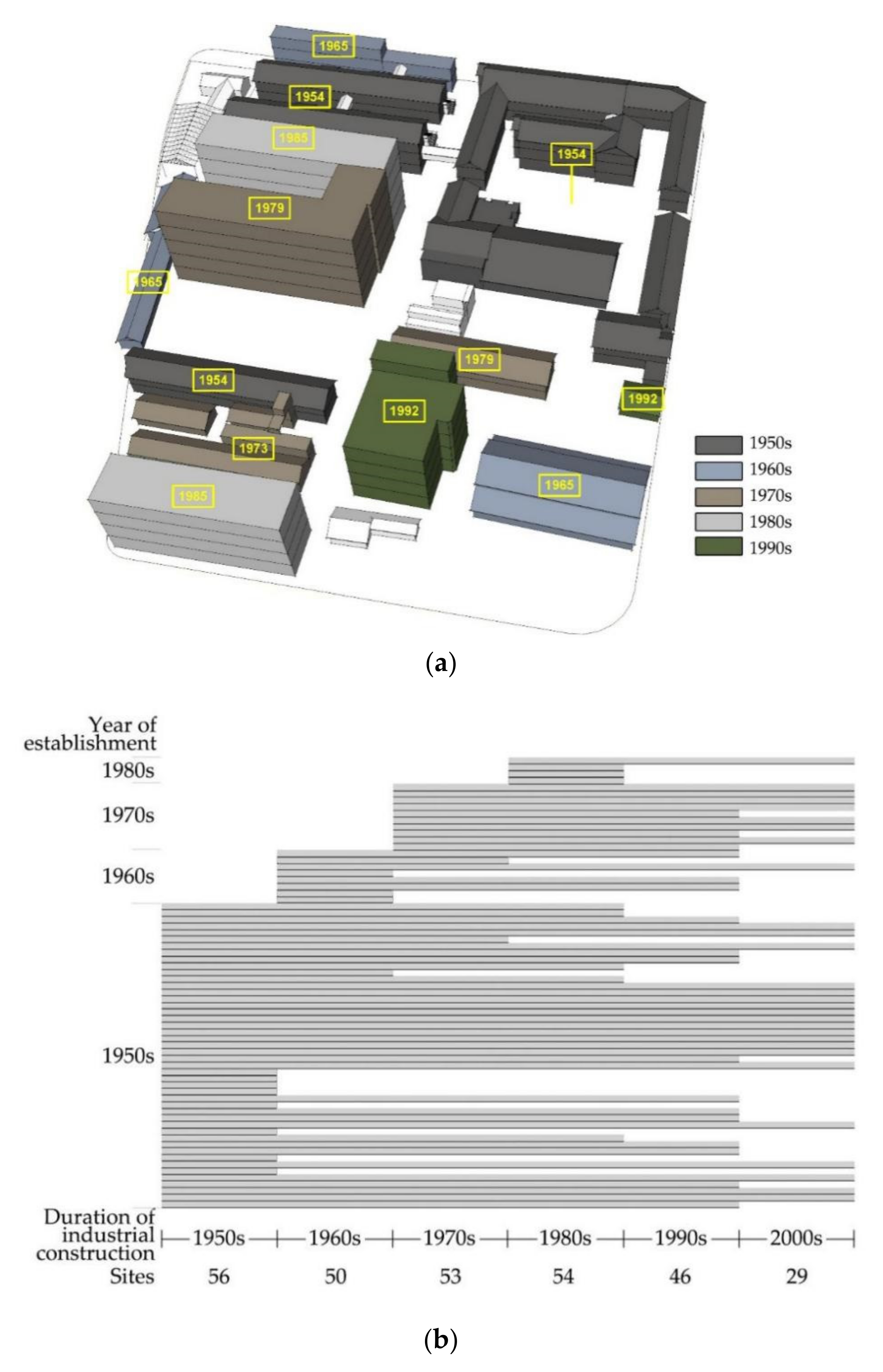
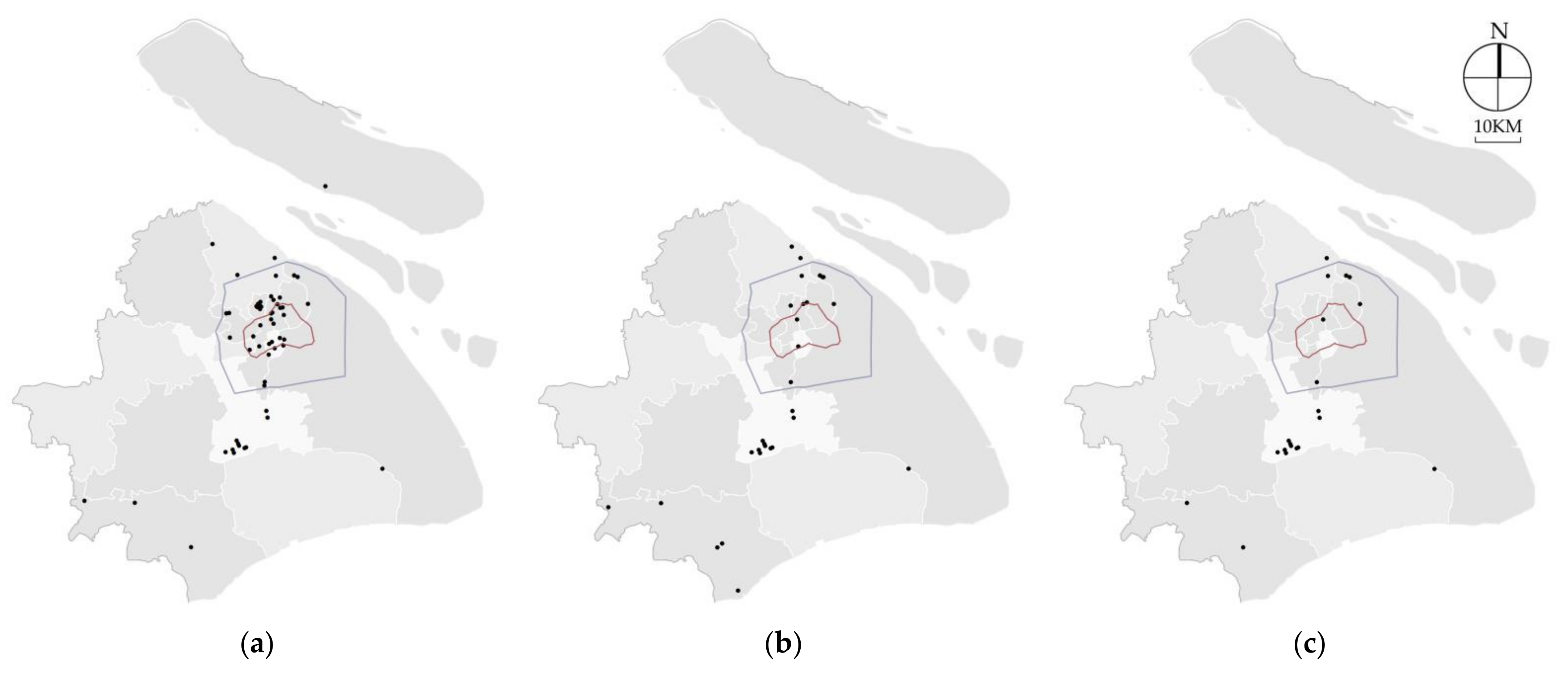
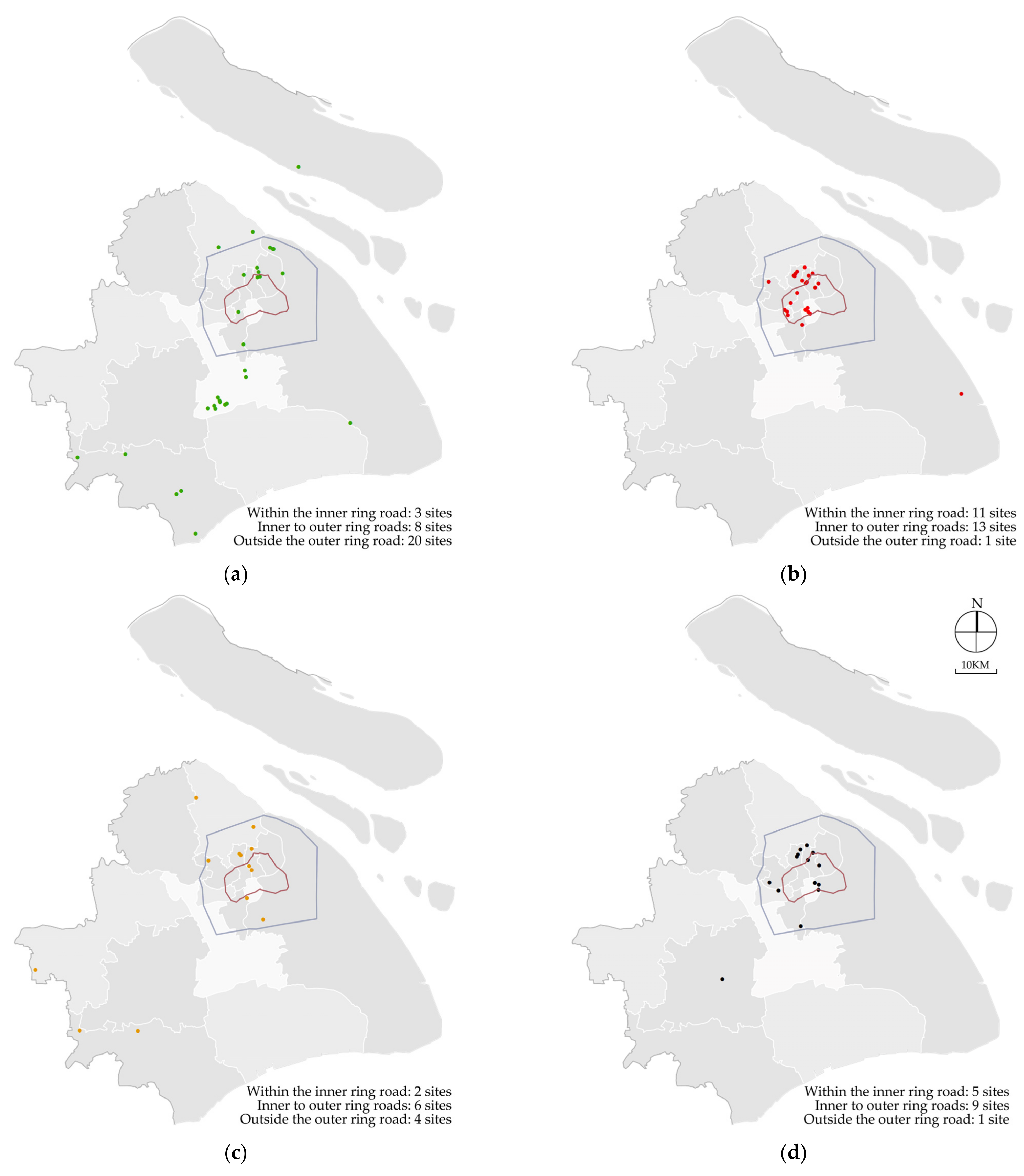
| Number | List | Source | The Number of Industrial Heritage Sites |
|---|---|---|---|
| 1 | Shanghai Immovable Cultural Relics | Shanghai Municipal People’s Government | 53 1,2 |
| 2 | Shanghai Heritage Architecture | Shanghai Municipal People’s Government | 6 1 |
| 3 | Shanghai Heritage Blocks | Shanghai Urban Planning Bureau | 5 2 |
| 4 | Shanghai Industrial Heritage Survey | Shanghai Cultural Relics Bureau | 26 |
| Number | Criteria | Types |
|---|---|---|
| 1 | Geographical distribution | The inner city (within the inner ring road; mostly the previous concessions and the core of Pudong New District) |
| Mature neighborhoods (in-between the inner and outer ring roads; mostly 1949–1990s urban expansion) | ||
| Suburbs (outside the outer ring road) | ||
| 2 | Industrial type (according to Shanghai Local Chronicles and National Industrial Classifications GB/T4754-2011) | Heavy industry |
| Light industry | ||
| Non-industrial infrastructure and functions | ||
| 3 | Spatial form | Industrial building |
| Industrial block | ||
| Industrial zone | ||
| 4 | Preservation and regeneration | Functional continuation (maintaining the original industrial production) |
| Functional regeneration (adapted to other functions) | ||
| Not in use | ||
| Demolished |
| Major Categories (I) | Number | Subcategories (II) | Quantity | Proportion |
|---|---|---|---|---|
| I Heavy industry (65%) | 1 | Shipbuilding industry | 4 | 5% |
| 2 | Electric power industry | 4 | 5% | |
| 3 | Electronic instrumentation industry | 2 | 2% | |
| 4 | Iron and steel industry | 4 | 5% | |
| 5 | Aviation industry | 2 | 2% | |
| 6 | Chemical industry | 7 | 8% | |
| 7 | Electromechanical industry | 22 | 27% | |
| 8 | Building materials industry | 3 | 4% | |
| 9 | Coal industry | 1 | 1% | |
| 10 | Automobile industry | 2 | 2% | |
| 11 | General equipment manufacturing industry | 1 | 1% | |
| 12 | Rubber industry | 2 | 2% | |
| II Light industry (28%) | 13 | Film machinery Industry | 3 | 4% |
| 14 | Textile industry | 5 | 6% | |
| 15 | Household electrical appliance industry | 1 | 1% | |
| 16 | Metal products industry | 1 | 1% | |
| 17 | Food industry | 7 | 8% | |
| 18 | Toy industry | 1 | 1% | |
| 19 | Culture, education, sports industry | 1 | 1% | |
| 20 | Camera manufacturing industry | 1 | 1% | |
| 21 | Pen making industry | 2 | 2% | |
| 22 | Lock making industry | 1 | 1% | |
| III Non-industrial infrastructure and functions (7%) | 23 | Transportation | 1 | 1% |
| 24 | Warehousing | 1 | 1% | |
| 25 | Maritime | 1 | 1% | |
| 26 | Educational R & D | 3 | 4% |
Publisher’s Note: MDPI stays neutral with regard to jurisdictional claims in published maps and institutional affiliations. |
© 2022 by the authors. Licensee MDPI, Basel, Switzerland. This article is an open access article distributed under the terms and conditions of the Creative Commons Attribution (CC BY) license (https://creativecommons.org/licenses/by/4.0/).
Share and Cite
Mo, C.; Wang, L.; Rao, F. Typology, Preservation, and Regeneration of the Post-1949 Industrial Heritage in China: A Case Study of Shanghai. Land 2022, 11, 1527. https://doi.org/10.3390/land11091527
Mo C, Wang L, Rao F. Typology, Preservation, and Regeneration of the Post-1949 Industrial Heritage in China: A Case Study of Shanghai. Land. 2022; 11(9):1527. https://doi.org/10.3390/land11091527
Chicago/Turabian StyleMo, Chaoyu, Lin Wang, and Fujie Rao. 2022. "Typology, Preservation, and Regeneration of the Post-1949 Industrial Heritage in China: A Case Study of Shanghai" Land 11, no. 9: 1527. https://doi.org/10.3390/land11091527
APA StyleMo, C., Wang, L., & Rao, F. (2022). Typology, Preservation, and Regeneration of the Post-1949 Industrial Heritage in China: A Case Study of Shanghai. Land, 11(9), 1527. https://doi.org/10.3390/land11091527






